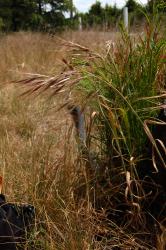- Taxon
- Gallery
Annuals, 20–90 cm, loosely tufted or consisting of a solitary culm. Leaf-sheath with soft, short, spreading hairs; upper sheaths ± glabrous near base. Ligule 1.5–4 mm, denticulate to lacerate. Leaf-blade 4–30 cm × 2–7 mm, with short, ± scattered hairs, scabrid near acute tip. Culm 10–65 cm, erect or ascending, internodes with very short hairs below nodes and below panicle. Panicle 10–28 cm, very lax and nodding; branches spreading, slender, scabrid, tipped by 1–(2) spikelets. Spikelets 5.5–9.5 cm, 5–8-flowered, oblong-lanceolate to later wedge-shaped and gaping, greyish green to purplish. Glumes unequal, very narrow, acuminate, membranous, glabrous, but sparsely scabrid on keels and nerves in upper ½; lower 13–22 mm, 1–(3)-nerved, upper 20–30 mm, 3–(5)-nerved. Lemma 20–35 mm, 7-nerved, rounded, lanceolate, minutely scabrid, tapering to 2 acute to acuminate, hyaline, smooth to finely scabrid lobes 4–5 mm; awn 30–60 mm. Palea c. ⅔ length of lemma, keels sparsely ciliate. Callus with minute hairs. Rachilla 4–6 mm, finely, minutely scabrid. Stamens 2–3; anthers 1–3 mm. Caryopsis 11–13 × 1.5–2.8 mm. Plate 3A.
[From: Edgar and Connor (2000) Flora of New Zealand. Volume 5 (second printing).]




